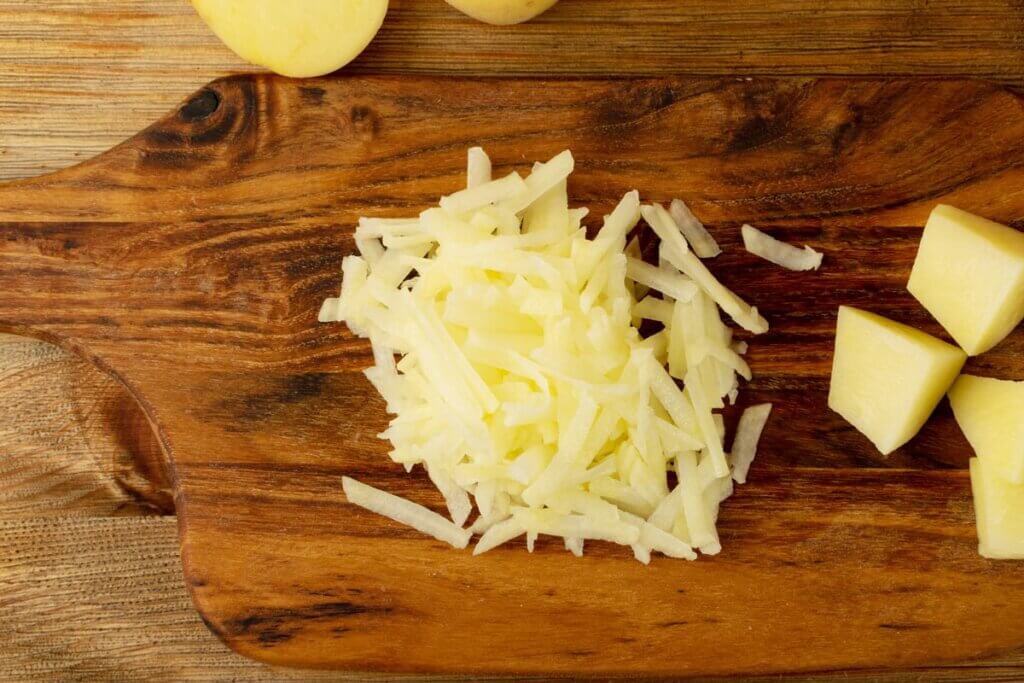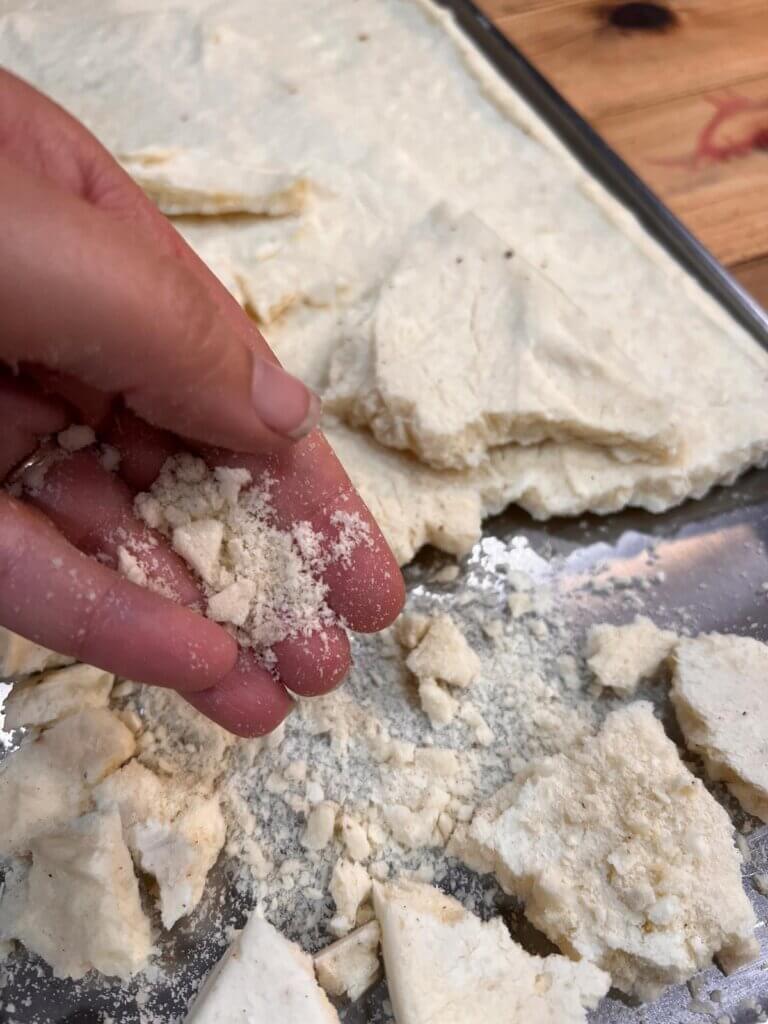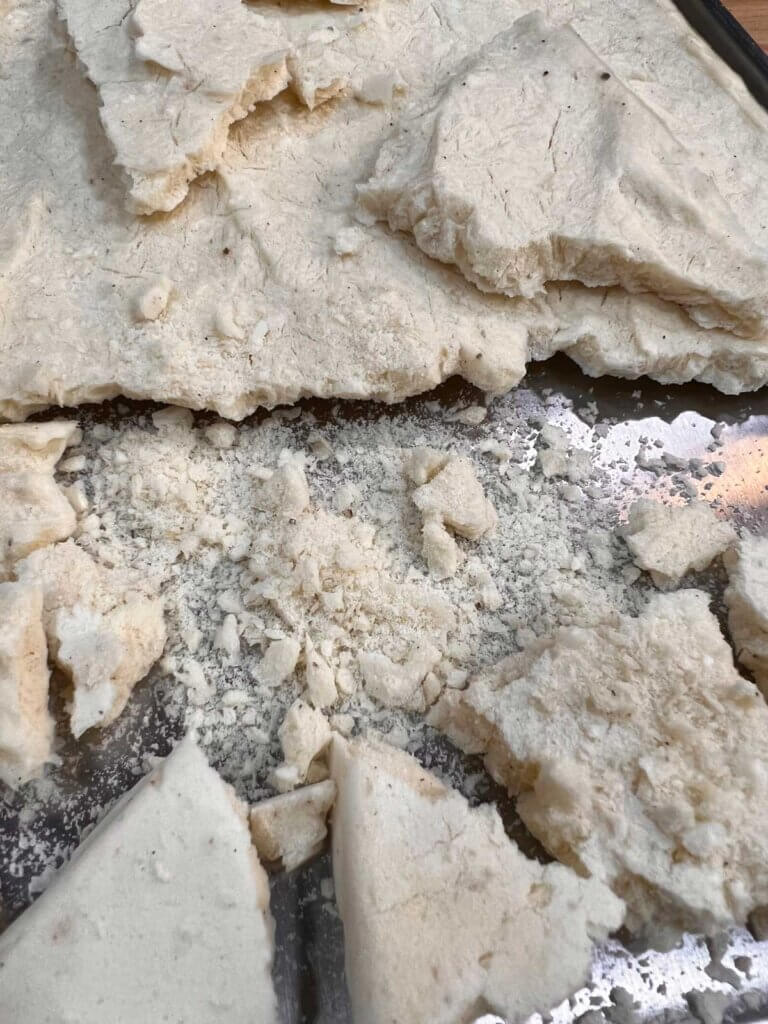Potatoes remain a staple in backyard gardens and on the family dinner table for good reason. They’re relatively easy to make, versatile, delicious, fun to grow, and abundant. We love keeping our potatoes in our root cellar (aka, under the basement steps) and canning potatoes. But for those that are ready-to-eat, freeze drying potatoes is absolutely the way to go when it comes to preserving them. When you reconstitute them, they taste just as good as fresh, homemade potatoes.

Learn to make freeze dried potatoes to make meal times quick and easy. You can dice, mash, shred, or flake your potatoes for later use in any of your standby potato dishes or recipes.
Can Potatoes Be Freeze Dried
With a big family, we try to raise or grow the bulk of our food. We love knowing that our food contains healthy nutrients without all the chemicals and preservatives. With that in mind, we preserve our homegrown vegetables, fruit, and meat to use all year long.
We use canning, fermentation, drying or dehydrating, and freezing methods throughout our food preservation year. We also like to use the freeze dryer. Using freeze drying as a preservation method offers great health benefits since it retains the vitamins and minerals, so it’s almost like eating fresh food. Be sure you know the foods you should not freeze dry!

If you’re looking into buying a freeze dryer, here is our honest review of the Harvest Right freeze dryer. Freeze dried food can remain nutrient-dense for up to 25 years, but we only aim to put up enough food for one to two years, depending on what we’re preserving.
Freeze dried food also makes excellent meals for camping or backpacking as they are lightweight and easy to reconstitute.
There is so much you can do with a freeze dryer. We love freeze dried avocados and guacamole, freeze dried tomatoes, freeze dried corn, freeze dried chicken, freeze dried berries, and so much more! (We even freeze dry our homemade dog food!)
Freeze drying potatoes is also a must. You just need to cook the potatoes first. Otherwise, they will turn black during the preservation process. You can partially cook them, but they must be at least blanched to stop the blackening.

Tips for Perfect Freeze Dried Potatoes
- Size – Smaller pieces of potato freeze dry and reconstitute much more quickly than larger ones. Homesteading Hack: As you slice, dice, or shred your potatoes, place them in cold water until you finish cutting up the batch so the potatoes stay white as you prepare the remaining potatoes.
- Blanch Your Potatoes – The enzymes in potatoes cause them to turn gray or black when exposed to air. They can also lose their flavor or texture. You can avoid these issues if you blanch or cook your potatoes in hot water before freeze drying. You don’t need to cook the potatoes fully; you can just blanch them for a few minutes depending on the size of the potato pieces. You can also freeze dry baked potatoes. Allow enough time for the potatoes to cool completely.
- Pre-Freezing – Putting your blanched or cooked potatoes on trays in the freezer ahead of time can speed up the freeze drying process, but it isn’t necessary.

Ways to Make Freeze Dried Potatoes
Slices
Slice your potatoes into thin slices to freeze dry. Blanch them for one minute if you cut paper-thin slices. If you cut thick slices a quarter of an inch or more, blanch them for 5 to 12 minutes.
When you reconstitute sliced potatoes, you can make them into scalloped potatoes, au gratin, or boulangere (or boulangerie) potatoes. These dishes would make an excellent side for my easy meatloaf recipe or this roasted chicken recipe.

Cubed
You can use freeze dried cubed potatoes to make potato salad, breakfast potatoes, soups, or this sweet pepper hash recipe. If you are still deciding how to use your freeze dried potatoes, diced potatoes are a versatile option.
Depending on the size of the cubes, your blanching time will vary. If they are small cubes, blanch for 2-3 minutes and up to 10 minutes for larger cubes. You just don’t want to overcook your potatoes. Pull them out of the boiling water while they’re still firm and before they become mushy.

Shredded
Of course, freeze dried shredded potatoes make great hashbrowns! They also make a wonderful side for this delicious bacon frittata or scrambled eggs.
If you blanch potato shreds, they only need to soak in the boiling water for several seconds. After blanching the potato shreds, place them directly into an ice water bath to stop the cooking process so the potato shreds keep from becoming too soft and mushy.

Mashed
Freeze dried mashed potatoes make an easy side to just about any meal, like this corned beef from scratch. Surprisingly, freeze dried mashed potatoes taste just like fresh, homemade mashed potatoes (much different than the freeze dried mashed potatoes from the store).
Make your favorite mashed potato recipe, but don’t add the butter, cheese, or milk products until the reconstitution stage. Adding the fats later on increases the shelf-life of the mashed potatoes.

Supplies Needed
- Freeze Dryer – We have multiple Harvest Right Freeze Dryers. They come in four sizes, but I recommend purchasing the largest model that fits your budget. I don’t think you’ll ever regret having more space.
- Cutting Board and Knife – Choose a large cutting board with plenty of space for chopping potatoes and a sharp knife to make chopping go quicker.
- Peeler – If you want to peel your potatoes first, use a peeler. You can use the peels to make Potato Peel Pie. This is optional, however. Leaving the potato skins on the potatoes adds more nutrients to your food.
- Trays – Use the trays that come with the freeze dryer.
- Parchment Paper or Silicone Mats (optional) – These options keep food from sticking to your trays.
- Towels – Tea towels or paper towels are handy to pat dry your potato slices after cooling.
- Mason Jars or Mylar Bags – Store your freeze dried foods in sealed containers. I prefer Mason jars that can be sealed airtight to keep moisture out. If you use Mason jars, I recommend this jar sealer to get an airtight seal.
- Oxygen Absorbers – Like moisture, oxygen leads to food spoilage. Using oxygen absorbers can keep your freeze dried foods fresher for longer. I find they’re not necessary as long as I reseal the jars after each opening.
- Labels and Marking Pen – It’s always a good idea to label your stored foods with the name of the food and the date.

Ingredients Needed
- Potatoes – Use the variety of potatoes that you love. Any variety works!
How to Freeze Dry Step by Step
- Wash your potatoes and peel them if you’d like.
- Slice, cube, or shred your potatoes based on your preference.
- Boil a large pot of water.
- Blanch your potatoes according to their size. If your slices or shreds are thin, you only need to blanch them for several seconds to a minute. If your pieces are small but not thin, blanch them for 2-3 minutes and for larger pieces, blanch them for up to 10 minutes. If making freeze dried mashed potatoes, fully cook the potatoes to your preferred doneness.
- Allow your potatoes to cool completely, drying them with a paper towel if needed.
- Spread them on the freeze dryer trays lined with parchment paper or silicone mats. For freeze dried mashed potatoes, spread them into a thin layer using a spatula.
- You can place them in the freezer to pre-freeze or put them right into your freeze dryer.
- Turn your freeze dryer on and select the pre-frozen option (if you chose to pre-freeze your potatoes) or not frozen (if you did not pre-freeze your potatoes).
- Place the trays into the freeze dryer and follow the manufacturer’s instructions for freeze drying.
- When completed, double-check to make sure the potatoes are fully freeze dried (see tips below for how to tell if potatoes are done). If they’re not fully freeze dried, add four to six hours more and check again.

How to Tell If the Potatoes Are Done
Freeze dried potatoes feel dry and crispy when finished and freeze dried mashed potatoes will crumble into a powder. Make sure all the potatoes on the tray feel dry with no cold spots. If they feel moist, spongy, soft or cool to the touch, they need an additional 4 to 6 hours in the freeze dryer.
How to Rehydrate Freeze Dried Potatoes
The technical way to reconstitute any freeze dried food is to weigh the tray before freeze drying, then weigh the tray after freeze drying; the difference in weight is how much water would need to be added back to the entire tray to rehydrate them.
You can divide your potatoes into serving sizes and do the math to figure out approximately how much water will need to be added back to each batch. Warm water rehydrates potatoes better than cool water.
If you didn’t weigh your trays, here are some ideas for reconstituting potatoes:
- Water – Place your freeze dried potatoes in a large bowl. Add warm water to the bowl until all the potato pieces are covered. Allow them to soak until they are rehydrated and strain off any remaining water.
- Milk – Do the same as above, but use warm milk instead of warm water. This makes the potatoes nice and creamy if you plan to use them for something like mashed or scalloped potatoes.
- Soup – You can add freeze dried potatoes directly to soups and stews. You may need to add extra liquid to the soup since the potatoes will soak up some of the broth or soup base.
- Steam – You can steam your potatoes to rehydrate them. This is preferred for more delicate potato dishes.

How to Store Freeze Dried Potatoes
Store all freeze dried foods in airtight containers away from direct light. You do not want to expose your freeze dried food to direct sunlight, moisture, or oxygen. When stored correctly, freeze dried potatoes have a shelf life of 25-30 years.
Use mylar bags or sealed Mason jars for food storage. Be sure to label and date the container. Since oxygen causes faster spoilage, if you want to store your food for longer than a year, we recommend resealing the jars after each time you open them. Additionally, you can add an optional oxygen absorber to the jar to help soak up any residual oxygen before sealing.

The Abundant Pantry: Freeze Drying Masterclass
If you are ready to take your freeze drying skills to the next level, you don’t want to miss my Freeze Drying Masterclass. This class was designed to be taken independently or as a companion to my book Freeze Drying the Harvest. In this online course, you will receive:
- 70+ detailed video lessons, including step-by-step setup instructions and complete batch walkthroughs for fruit, veggies, meat, meals, liquids, living food, desserts and more!
- 24/7 Lifetime access! Watch over and over again, anytime!
- 166 Page Class workbook that includes pre-treatment instructions, rehydration charts and full recipes
- Complete the troubleshooting section to confidently navigate any errors
By the time you finish this class, you will be filling your pantry with nutrient-dense, delicious freeze dried fruit, veggies, milk, eggs, meat, meals (and more) like a pro. Enroll today and receive instant access!


















